Dodge WC series
The Dodge WC series, sometimes nicknamed 'Beeps',[nb 3] were a prolific range of light 4WD and medium 6WD military utility trucks, produced by Dodge / Fargo during World War II.[nb 4] Together with the 1⁄4-ton jeeps produced by Willys and Ford, the Dodge 1⁄2‑tons and 3⁄4‑tons made up nearly all of the light 4WD trucks supplied to the U.S. military in WWII – with Dodge contributing some 337,500 4WD units[nb 5] (over half as many as the jeep[10][5][nb 6]).
| Dodge WC series | |
|---|---|
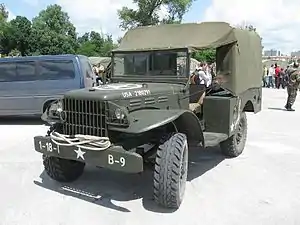 The most produced variants in the range were the 3⁄4-ton, 4×4, WC-51 and WC-52 Weapons Carriers – shown a WC-51: short front bumper, without winch. | |
| Type | 1⁄2-ton, 3⁄4-ton 4×4 truck 11⁄2-ton 6×6 truck |
| Place of origin | United States |
| Service history | |
| Wars | World War II Korean War Various post 1945 conflicts |
| Production history | |
| Manufacturer | Dodge / Fargo |
| Produced | 1940–1945 |
| No. built | Total: ~382,350 excl. variants Consisting of: 1⁄2-ton 4×2 models 1,542 units All 4×4 Models ~337,600 units – across: ~82,390 1⁄2-ton units (1940–1942) [1][2] [nb 1][nb 2] and 255,195 3⁄4-ton units (1942–1945) 11⁄2-ton 6×6 Models 43,224 units [4][5] |
| Variants | D8A 1⁄2-ton, 4×4 (1941, Canada) – 3,000 units [6] D3/4 APT 3⁄4-ton, 4×4 (1945, Canada) – 11,750 units [6] VF-401 – VF-407 11⁄2-ton, 4×4 (1940) – 6,472 units [7][8] T-203B 11⁄2-ton, 4×4 (1941) – 1,500 units WF-32 / G-618 11⁄2-ton, 4×2 (1942–1944, Iran) – 9,600 units |
| Specifications (WC-51 / WC-52[9]) | |
| Mass | 5,250 lb (2,380 kg) empty (5,550 lb (2,520 kg) with winch) |
| Length | 166 7⁄8 in (424 cm) (176 1⁄2 in (448 cm) with winch) |
| Width | 82 3⁄4 in (210 cm) |
| Height | 81 7⁄8 in (208 cm) |
| Engine | Dodge T-214 92 hp (69 kW) |
| Payload capacity | 1,500 pounds (680 kg) |
| Transmission | 4 speed × 1 range |
| Suspension | Live beam axles on leaf springs |
| Ground clearance | 10 23⁄32 in (27.2 cm) |
| Fuel capacity | 30 US gal (114 l) |
Operational range | 240 mi (386.2 km) |
| Maximum speed | 55 mph (89 km/h) |

Contrary to the versatility of the highly standardized jeep, which was mostly achieved through field modification, the Dodge WC‑series came in many different, purpose-built, but mechanically uniform variants from the factory, much akin to the later family of High Mobility Multipurpose Wheeled Vehicles. The WC series evolved out of, and was part of a more extended family of trucks, with great mechanical parts commonality, that included open- and closed-cab cargo trucks and weapons carriers, (radio) command cars, reconnaissance vehicles, ambulances, carryalls, panel vans, and telephone installation and mobile emergency / field workshop trucks.
The Dodge WC series were essentially built in two generations. From 1940 to early 1942, almost 82,400 of the 1⁄2‑ton 4×4 Dodge trucks were built — initially called the VC series, but the great majority (from 1941) in the WC series, and in more variants.[13][2] Contrary to what the nomenclature would suggest, the 1941 WC models were a direct evolution of the 1940 VC models, retaining the U.S. Army's G-505 Ordnance Corps Supply Catalog number.
In 1942, the payload was uprated, and the trucks grew into the G-502 3⁄4-ton 4×4 Truck (Dodge) and the G-507 11⁄2‑ton 6x6 personnel and cargo truck (Dodge) — confusingly retaining the Dodge WC model code. Although the 3⁄4‑tons featured significant design improvements, they did retain some 80% interchangeable components and service parts with the 1⁄2‑ton models[13] — a vital Army requirement, for field maintenance and operability of the trucks.
Dodge was the U.S. Army's main supplier of 1⁄2‑ton trucks, and its sole supplier of both 3⁄4‑ton trucks and 11⁄2‑ton 6x6 trucks in World War II.[5] With over a quarter million units built through August 1945, the G-502 3⁄4‑tons were the most common variants in the WC‑series.[5]
After the war, Dodge developed the 3⁄4-ton WC‑series into the civilian 4×4 Dodge Power Wagon; and in 1951, the WCs were replaced by the very similar 3⁄4‑ton 4x4 Dodge M-series vehicles .
Though the majority of Dodges built were 'Weapons Carriers', "WC" was not abbreviated from this, but a general Dodge model code – initially "W" for 1941, and "C" for a (nominal) half-ton payload rating. However, the "WC" model code was simply retained after 1941 — for both the 3⁄4-ton, as well as the 11⁄2‑ton rated 6x6 Dodges.[13]
All in all, not counting mechanically related variants, the WC series alone involved 52 model versions (thirty 1⁄2‑ton 4×4, eight 1⁄2‑ton 4×2, twelve 3⁄4‑ton 4×4, and two 11⁄2‑ton 6×6 models). Creating vehicles of a common platform in such a variety of designs, with payloads ranging from 1⁄2‑ton to 11⁄2‑tons, had no equal in its time, and is seen as an extraordinary feat of the WWII American auto industry.[14]
History and design
1900–1939 — Dodge Brothers start making cars and 4x4 trucks for the U.S. Army
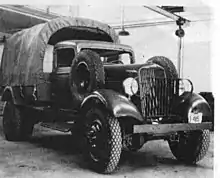
.jpg.webp)
Dodge had been the United States military's primary supplier of light wheeled vehicles, since before the U.S. joined the First World War.[15] After starting business in 1900, producing precision engine and chassis components for other car builders in Detroit — Ford and Oldsmobile chief among these — Dodge introduced their first car, the Model 30/35 tourer, in 1914. It was stronger and more high quality than the ubiquitous Ford Model T, and in 1916, Dodge cars proved their durability, both in the 1910s U.S.–Mexico Border War — the U.S. military's first operation to use truck convoys,[16] as well as in World War I, when some 12,800 Dodge cars and light trucks were used,[15] primarily as ambulances and repair trucks.,[17] but also as staff and reconnaissance vehicles. All the while, Dodge maintained its reputation for high quality truck, transmission, and motor parts they made for other successful manufacturers.
Dodge light trucks were initially based largely on their passenger cars, but later specific truck chassis and bodies were designed. Light- and medium-duty models were offered first, then a heavy-duty range was added during the 1930s and 1940s. Dodge developed its first four-wheel drive truck in 1934 — an experimental 11⁄2 ton for the U.S. Army, designated K-39-X-4(USA), of which 796 units were built in several configurations.[15][7] Timken supplied driven front axles and transfer-cases, which were added to a militarized commercial truck. The Timken transfer case was the first part-time design,[18] that allowed the driver to engage or disengage four-wheel drive using a lever inside the cabin.[17][19] In spite of the limited 1930s U.S. military budgets, the ’34 truck was liked well-enough that the 11⁄2 tonners were further developed. Dodge built the U.S. Army further batches of 4WD 11⁄2-ton cargo trucks in 1938, 1939 and 1940.[20] 1,700 RF-40-X-4(USA) trucks were procured in 1938, and 292 TF-40-X-4(USA) in 1939.[15] All of these 11⁄2-ton Army 4x4s rode on a 143 in (363 cm) wheelbase, and the 1938 RF-40 and 1939 TF-40 trucks were the first to receive a Dodge engineering code in the 200 range (T-200 and T-201 respectively).[7]
However, Dodge also eagerly pursued military contracts for half-ton four-by-fours at the same time. The smaller size had outperformed the 11⁄2-ton 4x4 during testing in 1938,[8] and Dodge had invested greatly in half- to one-ton trucks in prior years. In 1936, Dodge's light, car-based trucks had been crucially redesigned — dropping the old car frames and for the first time using modern, truck-style chassis, with side rails welded to the cross members on their half-ton to one-ton rated trucks.[21] Additionally, Dodge had built the all new, very large Warren Truck Assembly plant in Michigan for its light and medium trucks, opened in 1938. In 1939 again, Dodge presented a completely redesigned line of pickups and trucks: the art-deco styled, "Job-Rated" trucks, aimed to fit every job.[21]
_from_SNL_G-657.jpg.webp)
1940 – 1⁄2-ton VC and 11⁄2-ton VF models
.jpg.webp)
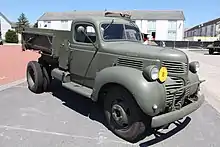
Well before the onset of World War II, it was clear that the USA needed to update its military. The Quartermaster Corps (Q.C.), responsible at the time for providing the military with non-combat vehicles, moved to standardize truck designs, and by 1939, as the war in Europe exploded, the Army had settled on five payload-based general-purpose truck classes: 1⁄2-ton, 11⁄2-ton, 2 1⁄2-, 4- and 7 1⁄2-ton.[22] By June 1940 the Q.C. had tested and approved its first three standard commercial based, all-wheel drive trucks: the 11⁄2-ton 4x4 Dodge, the GMC 2 1⁄2-ton 6x6 and a Mack 6-ton 6x6.[23] With regards to Dodge however, the U.S. military reconsidered its preferences for the build-up for the war almost immediately after this.
Whereas in 1936, a Marmon-Herrington converted Ford had become the Army's first half-ton 4-wheel drive,[24] and the Army had initially standardized Dodge's 11⁄2-ton 4x4 truck — following Dodge's push for building 1⁄2‑tonners, after mid 1940 it was decided they preferred Dodge to build light-duty four-wheel drives, contracting for a series of half-ton trucks,[20] while GM / Chevrolet was instead going to become the standard supplier for 11⁄2-ton trucks.[5] So, when in the summer of 1940 the largest government truck contract awarded went to Chrysler's Dodge / Fargo Division, for more than 14,000 (mostly) 4x4 trucks,[25] this was in the midst of the transition, and thus included both orders for 1⁄2‑ton and 11⁄2‑ton trucks, as GM / Chevy still needed to tool up for the 11⁄2-tonners.
Dodge had started developing designs for a 4x4 half-ton in 1939, and began production in earnest in 1940 — both 4x4 half-tons, as well as 11⁄2-ton 4x4 and 4x2 trucks. On all 1940 trucks, front sheetmetal was mostly identical to the commercial VC and VF models of that year, with the addition of a big brush guard mounted in front of the grille and headlights. Except for the addition of 4-wheel drive, and custom bodies on the 1⁄2‑ton command cars, the trucks followed the 1939 procurement doctrine, to "use commercial trucks with only a few modifications such as brush guards and towing pintles to fit them for military use." [12]
The first of the 1⁄2-ton, 4x4, VC series military trucks were based on Dodge's 1939 civilian, one-ton rated model TC-series. The military VC models retained the civilian engine and wheelbase, but gained four-wheel drive, and a new internal technical code: T-202. Manufacturing of the Dodge VC models (SNL number G-505) began in 1940, making these the Army's first production half-ton 4WD trucks. The soldiers also called the light command reconnaissance vehicles "jeeps," but this was also common with several other vehicles at the time.[26] — before that term migrated to the quarter-tons, gradually starting in 1941.[27][28]
A total of 4,640 VC models were built across six variants – mostly pick-ups and reconnaissance cars. On the one hand, these 1⁄2‑ton VC trucks proved so successful, that much greater quantities were immediately ordered, and they were further developed into the G-505, 1⁄2‑ton WC models built in 1941. On the other hand, an even lighter and smaller 4x4 truck was needed: a quarter-ton, that would soon replace the Dodges as the U.S.' lightest 4x4 military trucks. Although no longer standard, the VC trucks remained in use until the end of the war.[29]
_from_SNL_G-657.jpg.webp)
In 1940, Dodge also built 6,472 four-wheel drive 11⁄2-ton trucks, under two U.S. contracts – one awarded to Dodge, and one to Fargo.[8][30][nb 7] The models VF-401 to VF-407 (or engine/tech type T-203 by Dodge – and G-621 by the Army), were a continuation of their experimental pre-war predecessors, the RF-40(-X) and TF-40(-X) (or T-200 / T-201), still riding on a chassis of the same 143 in (3.63 m) wheelbase. Production consisted of just over 6,000 closed cab, open bed cargo trucks, plus just under 400 dump-trucks.
Like on the 1⁄2-ton VC-series, the 1940 VF-400 11⁄2-ton models simply used civilian front sheet-metal, based on the 1939 commercial model TE-30 cab, with a brush-guard fitted in front of the grille and headlights — but with a Dodge developed front driving axle, directional, cross-country tires, and a military cargo body.[31] Importantly, one thousand of the VF-400 series cargo trucks were equipped with a power take-off, gear-driven Braden model MU 10,000 lb (4,500 kg) capacity winch — a feature that was carried over on many of the subsequent 1⁄2-ton and 11⁄2-ton WC series models, directly from 1941. And although the light-duty WC models that followed, did not receive the VF-400's two-speed transfer cases, these did return on the 11⁄2-ton WC-62 and WC-63. An ambulance model, VF-407, was also designed, but only three units were built, likely experimental.[1][32]
These proved to be the last of Dodge's 11⁄2-ton 4x4 trucks for the war. Although the Army had steadily taken the bulk of its trucks in this category from Dodge / Fargo up til then, further production of 11⁄2-ton 4x4 trucks was instead awarded to GM's Chevrolet G506, which became the standard in this segment for the rest of the war.[8]
Aside from four-wheel drive trucks, production started for a militarized commercial 11⁄2-ton, rear-wheel drive truck in 1940 — initially Dodge's model VF-31, cargo (engineering code T-98) under the government SNL number G-618. The 4x2 model VF-31 was succeeded by the model WF-31 (internally T-118) for 1941 (closed cab tractor) and 1942 (cab and chassis) — both on a 135 in (3.43 m) wheelbase — and the 1942 model WF-32, closed cab, stake and platform cargo truck, on a 160 in (4.06 m) wheelbase.[33][1] After a modest production of 516 units of the WF-31,[32] at least 9,500 Dodge WF-32 trucks were built, mostly for lend-lease to Russia.[34][35][36]
| External video | |
|---|---|
| Dodge trucks in 1940 U.S. war promotion film | |
1941–1942 – 1⁄2-ton WC series
_(cropped).jpg.webp)
The 1940 VC-series Dodge 1⁄2-ton 4x4s were well liked but considered only an interim solution, because they were essentially a modified civilian truck. At the outset of World War II a more military design was laid out.[15] Dodge evolved the 1940 VC‑1 to VC‑6 into the equally half-ton rated WC series of military light trucks, produced in 38 model variants, of which 30 were four-wheel driven, in varying amounts — thousands of some models were produced, while only a few of some others were made. Where the military VC‑series still used much civilian sheet-metal, distinguished by a brush-guard in front of the grille — the WC‑series came with wide-open, almost flat fenders that prevented mud build-up, clogging rotation of the wheels — as well as a redesigned, sloping nose with an integrated, round, grated grille / brush-guard. A new ambulance with a fully enclosed, all-steel box rear body was designed, on a longer, 123 inch wheelbase; and PTO-driven winches were now fitted to some models.
The 1⁄2‑ton WC models were the first all-military design Dodge developed in the build-up to full mobilization for World War II,[13] and they were the U.S. Army's first standard light 4x4 trucks — prior to the quarter-tons — when the U.S. formally declared war in December 1941.[15] Soldiers would sometimes call the new vehicles 'jeeps', as was still common practice before the term migrated to the yet to be introduced Willys and Ford trucks, and eventually stuck to those.[26]
Both the Dodge half-ton VC and WC trucks were part of the Army G-505 series. Some 77,750 four-wheel drive 1⁄2‑ton WC numbered trucks were produced during late 1940 to 1942 under War Department contracts.[1][2][nb 2] Additionally, aside from the fully military 4WD models, a small total of 1,542 two-wheel drive units retaining civilian sheet-metal were also supplied to the U.S. military, bearing WC model numbers in this same range. These models carried the SNL-code G-613, and brought the total number of half-ton WC‑series up to some 79,300 units, and the grand total of all half-tonners (VC and WC; 4WD and 2WD) to almost 84,000.
1942–1945 – 3⁄4-ton and 11⁄2-ton WC series
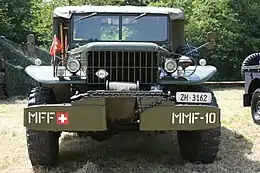
.jpeg.webp)
In 1940 the Army revised its range of standard, payload-based, general-purpose truck classes: a 1⁄4-ton chassis requirement was added; the 1⁄2-ton was to be replaced by a 3⁄4-ton, and additional heavy categories were specified.[22] The Quartermaster General wanted to start direct negotiations with Dodge, GM and Mack for certain models immediately, but not until after February 1941 could the Quartermaster Corps choose manufacturers directly, based on their engineering and production capabilities.[22] One deciding factor had to do with availability of certain critical components, like transfer cases and especially constant-velocity joints, not used much on commercial trucks, but all-wheel drive vehicles all needed these; plus additionally, they would use two or three times the amount of driven axles, meaning more gears to cut for all the differentials. Produced up to the war by a few specialized firms with limited capacity, from spring 1942 Ford, Dodge and Chevrolet joined in fabricating these in mass quantity,[25] with Dodge's experience in making quality, precision parts dating back from the earliest beginnings of the company.
While very successful, the 1⁄2-ton WC trucks had to be supplanted by new 3⁄4‑ton trucks. In late 1941, Dodge introduced a redesigned WC‑series 4x4 trucks uprated to 3⁄4‑ton and their SNL code changed to G-502. The 3⁄4‑ton featured a lower profile truck bed that could seat eight troops, plus under seat stowage compartments; while service-parts remained 80 percent interchangeable with the existing 1⁄2‑ton series.[15] Maintaining 80% service parts interchangeability with the 1⁄2‑ton models was of great value. The 3⁄4‑ton models could swiftly be deployed, and the 1⁄2‑ton, G-505 WC‑trucks remained in use to the end of World War II.[13]
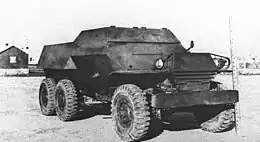
Throughout the war, Dodge was the U.S. Army's sole producer of 3⁄4‑ton trucks, and built a total of 255,193 of these across all variants from April 1942 to August 1945.[5][37][38] Standard vehicles in the 3⁄4‑ton 4x4 class were the WC-51 / WC-52 Weapons Carrier, WC-56 /-57 /-58 (Radio) Command Reconnaissance, WC-53 Carry‑all, and the WC-54 Ambulance. In the cargo/troop and command trucks, the WC-52 and WC-57 are identical to the WC-51 and WC-56, but with a longer frame, extending to carry the protruding front bumper with front-mounted winch.[39]
When the U.S. Army reorganized from using eight-troop rifle squads to twelve-men squads, the 3⁄4‑ton, 4x4, WC-51 and WC-52 trucks were also stretched into the 1943, G-507, 11⁄2‑ton, 6x6, troop and weapons carriers, to move 12-troop units per vehicle.
Further development
A single armored car prototype was built, based on the 11⁄2‑ton, 6x6, Dodge WC-62.
Models table – overview
_from_SNL_G-657.jpg.webp)
The table includes data on the relation between government and Dodge identification numbers, chassis payload rating, wheels and drive, and types of body fitted, according to the US Army Ordnance SNL supply list.[33][40] The initial Dodge VC series 1⁄2-ton trucks are seen as part of the SNL G-505 range by the military.
| External image | |
|---|---|
In the case of vehicle identifications separated by a slash, the first number refers to a vehicle without winch, and the second to a vehicle fitted with a winch, typically resulting in a 10 in (25 cm) longer front overhang, and significantly reduced approach angle. Not only were the winches driven by a power take-off from the engine,[9] but unlike the later Dodge M-series trucks, on which an extension was bolted to the frame when mounting a winch — on the WC‑series the winch equipped versions actually had a different frame.[41][42]
On the 11⁄2-ton rated VF-400 series trucks, the PTO-driven winch had a 10,000 pound capacity, but added almost 1,000 pounds to the vehicles weight, reducing the payload to 2400 pounds.[43]
Numbers separated by a comma indicate similar models but with different secondary details.
| 1⁄2-ton 4×4 – G-505 | 1⁄2-ton 4×2 | 3⁄4-ton 4×4 – G-502 | 11⁄2-ton 4×4 | 11⁄2-ton 4×2 | 11⁄2-ton 6×6 | ||||
| T-202 | T-207 | T-211 | T-215 | G-613 / T-112 | T-214 | G-621 / T-203 | G-618 / T-118 | G-507 / T-223 | |
| Pick-up, closed cab, w. troop seats | VC-3 | WC-1 | WC-12, WC-14 | WC-40 | WC-38, WC-47 | ||||
| Pick-up, closed cab, no rear seats | VC-4 | WC-5 | VF-401 / 402, VF-404 / 405 | ||||||
| Pick-up, open cab, weapons and troops | VC-5 | WC-3 / WC-4 | WC-13 | WC-21 / WC-22 | WC-51 / WC-52 | WC-62 / WC-63 | |||
| Carry-all | VC-6 | WC-10 | WC-17 | WC-26 | WC-36, WC-48 | WC-53 | |||
| Dump truck | VF-403, VF-406 | ||||||||
| Command / Reconnaissance | VC-1 | WC-6 / WC-7 | WC-15 | WC-23 / WC-24 | WC-56 / WC-57 | ||||
| Radio truck | VC-2 | WC-8 | WC-16 | WC-25 | WC-58, (WC-54) | ||||
| Panel Van | WC-11 | WC-19 | WC-42 | WC-37, WC-49 | |||||
| Emergency Repair (mobile workshop) | WC-41 | WC-60 | |||||||
| Maintenance | WC-43 | WC-60 | |||||||
| Portee gun truck [nb 8] | WC-55 | ||||||||
| Ambulance | WC-9 | WC-18 | WC-27 | WC-54, WC-64 (KD) | VF-407 | ||||
| Telephone installation / maintenance | WC-43 | WC-39, WC-50 | WC-59, WC-61 | ||||||
| closed cab, bare chassis | WC-20 | WC-41 | WF-31 | ||||||
Engines and drivetrains
All engines were liquid-cooled, straight-six Chrysler flathead gasoline engines, mated to four-speed manual transmissions and a single-range transfer-case offering part-time four-wheel drive.[44][45] Only the T203 and the T223 configurations applied in the 11⁄2-ton VF-400 models, and in the G-507 6×6 trucks had a dual-ratio transfer-case.[43][11]
| Tech. code | Since [46] | Block [47] | Bore | Stroke | Displacement [48] | Compression | Torque | Power |
|---|---|---|---|---|---|---|---|---|
| T112 | 1941 | 23 inch | 3 1⁄4 in (83 mm) | 4 3⁄8 in (111 mm) | 217.7 cu in (3,567 cm3) | 6.8:1 [49] | 170 lb⋅ft (230 N⋅m) @ 1200 rpm [50] | 85 hp (63 kW) @ 3000 rpm [50] |
| T118 | 1941 | 25 inch | 3.44 in (87 mm) | 4 1⁄4 in (108 mm) | 236.6 cu in (3,877 cm3) | 190 lb⋅ft (258 N⋅m) @ 1500–2200 rpm | 104 hp (78 kW) @ 3000 rpm [51] | |
| T202 | 1940 | 23 inch | 3 1⁄8 in (79 mm) | 4 3⁄8 in (111 mm) | 201.3 cu in (3,299 cm3) | 6.7:1 | 154 lb⋅ft (209 N⋅m) [52] | 79 hp (59 kW) @ 3000 rpm [44][29] |
| T203 | 1940 | 25 inch | 3 3⁄8 in (86 mm) | 4 1⁄2 in (114 mm) | 241.5 cu in (3,957 cm3) | 6.5:1 | 188 lb⋅ft (255 N⋅m) @ 1200 rpm | 99 hp (74 kW) @ 3000 rpm [53] |
| T207 [nb 9] | 1941 | 23 inch | 3 1⁄4 in (83 mm) | 4 3⁄8 in (111 mm) | 217.7 cu in (3,567 cm3) | 6.5:1 | 170 lb⋅ft (230 N⋅m) @ 1200 rpm [55] | 85 hp (63 kW) @ 3000 rpm [55][44] |
| T211 | 1941 | 23 inch | 3 1⁄4 in (83 mm) | 4 3⁄8 in (111 mm) | 217.7 cu in (3,567 cm3) | 6.5:1 | 170 lb⋅ft (230 N⋅m) @ 1200 rpm [55] | 85 hp (63 kW) @ 3000 rpm [55] |
| T211 from August 1941 [13] | 23 inch | 3 1⁄4 in (83 mm) | 4 5⁄8 in (117 mm) | 230.2 cu in (3,772 cm3) | 6.7:1 | 92 hp (69 kW) [19] | ||
| T214 | 1942 | 23 inch | 3 1⁄4 in (83 mm) | 4 5⁄8 in (117 mm) | 230.2 cu in (3,772 cm3) | 6.7:1 | 180 lb⋅ft (244 N⋅m) @ 1200 rpm [56] | 92 hp (69 kW) gross 76 hp (57 kW) net @ 3200 rpm [57][15] |
| T215 | 1941 | 23 inch | 3 1⁄4 in (83 mm) | 4 5⁄8 in (117 mm) | 230.2 cu in (3,772 cm3) | 6.7:1 | 180 lb⋅ft (244 N⋅m) @ 1200 rpm [58] | 92 hp (69 kW) @ 3100 rpm [58][44] |
| T223 | 1943 | 23 inch | 3 1⁄4 in (83 mm) | 4 5⁄8 in (117 mm) | 230.2 cu in (3,772 cm3) | 6.75:1 | 180 lb⋅ft (244 N⋅m) @ 1200 rpm [59] | 92 hp (69 kW) gross 76 hp (57 kW) net @ 3200 rpm [59] |
Half-ton VC series
_from_SNL_G-657.jpg.webp)
_from_SNL_G-657.jpg.webp)
The 1940 Dodge / Fargo VC models formed the first production run in the U.S. military's G-505 range of four-wheel drive, half-ton, light military trucks. Created based on Chrysler's civilian one-ton rated range of light trucks and carry-all,[29] the VC models formed the foundation for the subsequent WC series.
All variants used the same 116 in (295 cm) wheelbase as the commercial trucks, but with the addition of four-wheel drive. Bodywork and sheet metal on the pick-ups and carryall were largely copied from the civilian models — however, for the reconnaissance and radio cars, a dedicated open four seater body was created. Also the same 201.3 cu in (3.3 l) inline six, flathead engine was used, but horsepower was raised from a 70 hp (52 kW) civilian rating in 1939 [60][61] to 79 hp (59 kW) at 3000 rpm in the G-505.[44][29] The transmission had 4 speeds and the transfer case had one.
The VC series came in six variants, numbered VC-1 to VC-6, and internally T-202 by Dodge: [29][1]
- VC-1: Command Reconnaissance – 2,155 units
- VC-2: Radio Command Reconnaissance – 34 units
- VC-3: Closed cab Pickup with bed seating for troops – 816 units
- VC-4: Closed cab Pickup without bed seats – 4 units
- VC-5: Open cab Pickup with bed seating for troops – 1,607 units
- VC-6: Carry-all – 24 units
None of these trucks came with winches yet.
Half-ton WC series
From the start of production in late 1940,[62][2] until replacement by the 3⁄4‑ton models in early 1942, the G-505 half-ton, 4WD, Dodge WC models evolved from the VC series, through three mechanical engineering versions — T-207, T-211, and T-215 — in barely a year and a half; while receiving the T-215 specification engine midway through production of the T-211 coded versions. Half-ton rated WC series models were numbered, roughly chronologically, in the WC-1 to WC-50 range, but skipping numbers WC-2, WC-28 to WC-35, and WC-44 to WC-46.
The distribution across the versions was: [38]
- 31,935 units of the WC-1 through WC-11 models, with the T-207 engineering code and a 217.7 cu in (3,567 cm3) engine with 85 hp (63 kW);
- 17,293 units of the WC-12 through WC-20 models, with the T-211 engineering code and initially the same engine, however during August 1941 the T211 engine was increased to 230.2 cu in (3,772 cm3) and 92 hp (69 kW), but the overall T-code number was not changed on affected models (e.g. WC-18) [13] [nb 10]
- 28,537 units of the WC-21 through WC-27 and WC-40 through WC-43 model, with the T-215 engineering code and a 230.2 cu in (3,772 cm3) engine with 92 HP.
T-207 range units had front axles with Bendix-Weiss constant-velocity joints, whereas T-211 and T-215 models were given front axles either made by Bendix or with Rzeppa design CV joints, made by Ford. Additionally, from the T-211 onwards, the rear brakes were 14-inch (360 mm) instead of 11-inch (280 mm) drums,[64] and on the T-215 a military instead of a civilian design dash panel, with round instead of square gauges was introduced.[13] Among the T-211 range versions, no single WC model number was explicitly used for any winch-equipped units.
A further 1,542 rear-wheel drive units (engineering code T-112) were built (WC-36 through WC-39, and WC-47 through WC-50 — mostly carry-alls and pick-ups), that retained civilian bodywork and front axles (one-ton on-road rating).
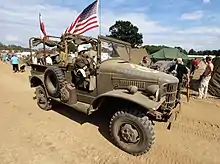
Common specifications of the 1/2 ton WC trucks were:
- Drive: four-wheel drive — except for WC-36 to WC-39 and WC-47 to WC-50
- Wheelbase: 116 in (295 cm) – both on four-wheel and two-wheel drive models
- except 123 in (312 cm) for ambulances and phone line / emergency repair trucks
- Track width: 59 3⁄8 in (151 cm) front – 61 3⁄8 in (156 cm) rear
- except 55 3⁄4 in (142 cm) front track on rear-wheel drive models
- Tires: 7.50×16
- Brakes: Hydraulic
- Engine: 6 cylinder, in-line, side valve engine
- Transmission: 4 forward/1 reverse, manual
- Transfer case: Single speed
1⁄2-ton Ambulances
WC-9, WC-18, WC-27
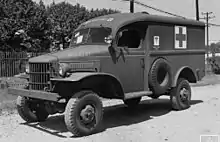
Entering production during 1941 to early 1942,[65] they were specifically designed to serve as military ambulances. These early variants are distinguishable from the later ones by having a curved radiator grille, while the later ones (WC-51 onwards) featured a flat grille. These versions were given a longer 123 in (3,100 mm) wheelbase.
- Length: 195 in (4.95 m)
- Width: 75 13⁄16 in (1.93 m)
- Height: 90 in (2.29 m)
- Weight: 5,340 lb (2,420 kg)
- Payload: 1,300 lb (590 kg)
_from_SNL_G-657.jpg.webp)
1⁄2-ton Carry-alls
WC-10, WC-17, WC-26, WC-36, WC-48
Carryall trucks with a nominal carrying capacity of 1,000 lb (450 kg). The WC-10, WC-17 and WC-26 followed engineering patterns T-207, T-211 and T-215 respectively — whereas the WC-36 and WC-48 were T-112, rear-wheel drive only models.
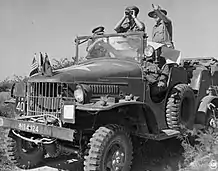
_pic2.JPG.webp)
1⁄2-ton (Radio) Command Reconnaissance
WC-6, WC-15, WC-23
Command / reconnaissance cars.
WC-7, WC-24
Command / reconnaissance car with winch.
WC-8, WC-16, WC-25
Radio car / Command reconnaissance car with radio, 12 volt.
.jpg.webp)
1⁄2-ton Trucks, Closed Cab
WC-1, WC-5, WC-12, WC-14, WC-40
Closed cab, two seater pickups with a nominal carrying capacity of a 1,000 lb (450 kg). Some portion of these models were manufactured with winch,[66] at least of the WC-12, the WC-14 (pictured), and the WC-40, reducing the payload to 700 lb (320 kg) — but no distinct model number was assigned for such units. The WC-12's engine displacement was increased to the T-215's volume of 230.2 cu in (3,772 cm3) mid-series, after engine No. 42001.[66]
1⁄2-ton Trucks, Open Cab
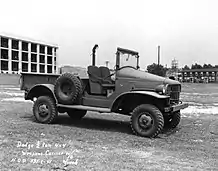
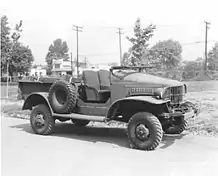
WC-3, WC-13, WC-21
Weapon carriers, two seater pickups with open cab. The open cab pickups could be fitted with an optional M24 machine gun mount, which bolted across the front of the bed. The mount could carry the M1918 Browning Automatic Rifle, as well as the M1919 Browning machine gun, and the 0.5 in (12.7 mm) M2 Browning machine gun.
- Length: 181 1⁄16 in (4.60 m)
- Width: 75 13⁄16 in (1.93 m)
- Height: with top 88 1⁄8 in (2.24 m)
- Weight: 4,440 lb (2,010 kg)
- Payload: 1,300 lb (590 kg)
WC-4, WC-22
Open cab weapons carrier, with Braden MU winch, and transverse seats, designed to tow the 37mm M3 anti-tank gun as well as carry the gun crew and ammunition. This type was usually issued to early tank destroyer units. 5570 built.
- Length: 191 5⁄16 in (4.86 m)
- Width: 75 13⁄16 in (1.93 m)
- Height: with top 88 1⁄8 in (2.24 m)
- Weight: 4,775 lb (2,166 kg) net
- Payload: 1,000 lb (450 kg)
.jpg.webp)
1⁄2-ton (Radio) Panel Vans
WC-11, WC-19, WC-42
Almost 1,400 panel van trucks, and panel van bodied radio communication cars. At first, regular panel van trucks were ordered: 642 units of WC-11,[62][67] and 103 units of WC-19.[63] The subsequent WC-42 panel vans were however furnished and equipped as radio communication cars. The 650 WC-42 radio panel vans almost outnumbered their bare transportation siblings, and they were also the only radio communication cars that Dodge built in a panel van body style in the entire VC and WC series range.
1⁄2-ton Telephone Service
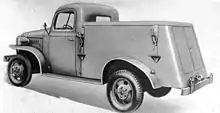
WC-39, WC-43, WC-50
These models were built as technical service trucks for the U.S. Army Signal Corps, designed to install and repair hard telephone lines. Together with some earlier 1⁄2‑ton GMC/Chevrolet models, and the later 3⁄4‑ton WC-59 and WC-61, they were also known by the Signal Corps as the K-50 trucks.
Of the two-wheel drive WC-39 and WC-50, only a single unit of each were built, but the four-wheel drive WC-43 numbered 370 units.
1⁄2-ton Trucks, Emergency Repair
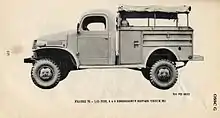
WC-5, WC-14, WC-20, WC-40, WC-41
Just over one thousand emergency repair chassis and trucks were ordered within the half-ton Dodge G-505, WC series.[62][63][68] The Dodge SNL G-657 Master Parts List doesn't explicitly list most of them as built to serve as emergency repair trucks, but the Summary Report of Acceptances, Tank-Automotive Materiel, 1940–1945, shows that at least 902 emergency repair chassis and trucks were received by the Army, and it involved at least all of the WC-14, WC-20 and WC-40 models, and most of the WC-41s.[69][70]
Dodge delivered at least all thirty WC-20, and most of the WC-41 units, as closed cabs with a bare chassis, on a 123 in (312 cm) wheelbase, fitted with dual rear tires.[69] Mostly furnished with third party utility service rear bodies, as M1 emergency repair trucks, for the purpose to provide mobile facilities for emergency ordnance repair (G-061 / G-505). One other body-type was ordered: one T-211 oil servicing truck in 1941.[63]
| U.S. Gvmt. Contract nr. | Tech model | Units ordered | Vehicle / body type – as ordered[62][63][68] | Units built | Model code | Vehicle / body type – Dodge description [1] | Units accepted | Summary Report of Acceptances model / type [70] |
|---|---|---|---|---|---|---|---|---|
| W-398-QM-8286 | T-207 | 60 | Emergency Repair | 60 | WC-5 | Closed cab pickup | – | – |
| W-398-QM-9388 | T-211 | 268 | Emergency Repair | 268 | WC-14 | Closed cab pickup | 298 | Emergency Repair, chassis |
| T-211 | 30 | Emergency Repair, chassis | 30 | WC-20 | Closed cab – bare chassis | |||
| W-398-QM-10327 | T-215 | 275 | Emergency Repair | 275 | WC-40 | Closed cab pickup | 275 | Emergency Repair |
| W-398-QM-10327 | T-215 | 267 | Emergency Repair, chassis | 267 | WC-41 | Closed cab – bare chassis | 213 | Emergency Repair, chassis |
| W-398-QM-11244 | T-215 | 39 | Emergency Repair | 39 | WC-41 | Closed cab | 39 | Emergency Repair, chassis |
| W-398-QM-11592 | T-215 | 77 | Emergency Repair, chassis | 77 | WC-41 | Emergency Repair, cab & chassis | 77 | Emergency Repair, chassis |
Three-quarter-ton models
.jpeg.webp)
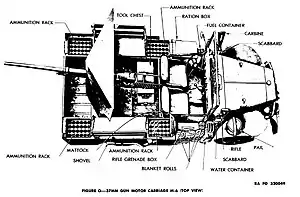
By late 1941, the Dodge WC range was significantly revised. All four-wheeled models were reinforced and uprated for a three-quarter ton off-road payload; and in 1943, a six-wheel drive, 11⁄2-ton variant was developed.
All models were widened to front and rear tracks of 64 3⁄4 in (164 cm), widening the front track by a full 5 inches (13 cm) — and tires increased from 7.50×16 to 9 inches (23 cm) wide. At the same time, the bulk production models were significantly shortened, giving the vehicles much more square proportions, akin to their new 1⁄4‑ton brother. Troops & weapons carriers, radio and command/reconnaissance trucks all went from a 116 in (295 cm) to a 98 in (249 cm) wheelbase. Only ambulances, carry-alls, and technical service trucks kept a long wheelbase. Panel vans were dropped from the range and no longer made.
With the nickname 'jeep' having migrated to the smaller 1⁄4‑ton trucks, some soldiers called the Dodges 'Beeps' (for "Big jeep") instead.[71]
The volume production pick-up/weapons carrier models received a redesigned rear bed, seating troops on top of the rear wheels, instead of between them, further widening these models to 6 ft 11 in (2.11 m). A single such unit, though compact, offered practical all-terrain transportation to a full eight man rifle squad and their gear.
The 3⁄4-tons kept the 6-cylinder inline, L-head engine of 92 hp (73 kW) gross, from the later model 1⁄2‑ton WC series.
Eventually, as much as half of the more than fifty different WC series models manufactured, were WC‑51 & WC‑52 cargo/troop and weapons carriers – and one third of those with an engine-powered front winch.
3⁄4-ton Ambulances
WC-54
_(owner_Glen_Rummery)_pic4.JPG.webp)
The WC-54 Truck, 3/4 ton, 4×4 Ambulance, Dodge (G-502), was produced as an ambulance, but a few were modified to serve as radio/telephone trucks with the US Signal Corps. A total of 26,002 WC-54 units were built from 1942 through 1944, after which the ambulance was redesigned, and replaced by the WC-64 in 1945.[72][73]
- Length: 16 ft 3 in (4.95 m)
- Width: 6 ft 6 in (1.98 m)
- Height: 7 ft 6 in (2.29 m)
- Weight: 5,920 lb (2,685 kg)
- Payload: 1,800 lb (820 kg)
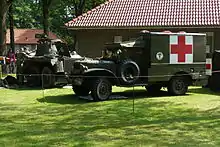
WC-64
The WC-64 KD Truck, 3/4 ton, 4x4 Ambulance Dodge (G-502) was an ambulance based on the same chassis as the WC-54 but with a knock-down body designed to increase the number of vehicles that could be shipped at the same time. The rear boxes were supplied in two major parts: lower and upper. The lower part of the box was attached to the chassis at the factory, while the upper box was crated for installation in the field.[74] 3,500 Knock-down ambulances were built between the beginning of 1945 and the end of the war,[75] the great majority (2,531 units) went to allies under lend-lease: [76]
- 1,123 to the Free French forces
- 644 to British Commonwealth
- 475 to China
- 149 to Brazil and 82 to other Latin American republics
3⁄4-ton Carryall
.JPG.webp)
.jpg.webp)
WC-53
A carryall, mechanically the WC-53 was virtually identical to the WC-54 but was fitted with a body which was the 1939 civilian carryall modified to military specifications. All four rear side windows were wind-up opening and the seating consisted of front folding passenger seat to allow rear access, two person second row leaving space to access to the rear full width three person seat. The spare wheel was carried on a mount on the driver's side and although the door was fully operational it could not be opened and the driver had to enter from the passenger side. The rear end had split tailgates.[77][78]
WC-53s were also fitted as radio trucks with a bench on the left side with the operator seated sideways. 8,400 WC-53: Truck, 3/4 ton, 4×4 Dodge Carryall (G-502) were built. No carryalls came from the factory with a winch, though there was a field modification available.[79]
- Length: 15 ft 6 in (4.72 m)
- Width: 6 ft 7 in (2.01 m)
- Height: 6 ft 8 in (2.03 m)
- Weight: 5,700 lb (2,590 kg)
- Payload: 1,750 lb (790 kg)
3⁄4-ton (Radio) Command Reconnaissance
WC-56
.jpg.webp)
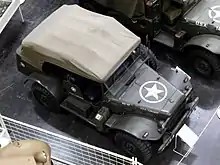
The WC-56 Truck, Command Reconnaissance, 3/4 ton, 4x4 w/o Winch Dodge (G-502) was a command and reconnaissance vehicle akin to a large quarter-ton jeep. It did not prove popular as it was heavier and not as maneuverable as the jeep, and its distinctive profile made it a target. The soft-top included side-curtains, for better weather shielding. 21,156 units were built.[80][73]
- Length: 13 ft 10 in (4.22 m)
- Width: 6 ft 7 in (2.00 m)
- Height: 6 ft 9 in (2.07 m)
- Weight: 5,335 lb (2,420 kg)
- Payload: 1,750 lb (800 kg)
WC-57
.jpg.webp)
The WC-57 Truck, Command Reconnaissance, 3/4 ton, 4x4 w/Winch Dodge (G-502) was identical to the WC-56, but fitted with a Braden MU2 7,500 lb (3,402 kg) capacity winch at the front bumper. 6,010 units built.[80][73]
- Length: 14 ft 8 in (4.46 m)
- Width: 6 ft 7 in (2.00 m)
- Height: 6 ft 9 in (2.07 m)
- Weight: 5,644 lb ( 2,560 kg)
- Payload: 1,750 lb (800 kg)
WC-58
The WC-58 Truck, Radio, 3/4 ton, 4×4 w/o Winch, Dodge (G-502) was identical to the WC-56 Command / Reconnaissance Car, but fitted with a Signal Corps Radio set in front of the rear seat, and a 12-volt electrical system.[81][82] Some WC-58 models may have been built, based on the WC-57 with winch, as well.[15][83] A total of 2,344 radio equipped units were built,[82] but it is unclear whether these were included as part of the WC-56 / WC-57 production, or constituted an additional 2,344 WC-58 radio car units.
- Length: 13 ft 10 in (4.22 m) / 14 ft 7 in (4.46 m) with winch
- Width: 6 ft 7 in (2.00 m)
- Height: 6 ft 9 in (2.07 m)
- Weight: 5,644 lb (2,560 kg)
- Payload: 1,750 lb (800 kg)
3⁄4-ton Trucks, Weapons Carrier
.jpg.webp)
_(cropped).jpg.webp)
WC-51 and WC-52 Almost three quarters of Dodge's 255,195 total 3⁄4‑ton G-502 WC series production were built as WC-51 and WC-52, "Truck, Cargo, 3⁄4‑ton, 4x4, Weapons Carrier". 123,541 were built without winch as the WC-51, and 59,114 with a front winch as the WC-52 — for a total of 182,655 units. Including the 5,380 WC-55s M6 Gun Motor Carriages that were later downgraded back to WC-52s brought the total number to over 188,000 cargo, troops and weapons carriers.
With the top and bows down, the WC-51 and -52 followed the low-profile design doctrine of the time. Lack of a winch gave the WC-51 a 10 in (25 cm) shorter front overhang, and thus a better approach angle. The open cab pickup could be fitted with an optional M24A1 machine gun mount, which bolted across the front of the bed. The mount could carry the M1918 Browning Automatic Rifle, the M1919 Browning machine gun, or the M2 Browning machine gun.
The WC-52 not only differed from the WC-51 by having a power take-off driven Braden MU-2 7,500 lb (3,400 kg) capacity winch at the front bumper, but to accommodate it, the WC-52 was actually built on a different, longer frame. A winch was therefore not easily added in the field.
- Length: 13 ft 11 in (4.24 m) – 14 ft 9 in (4.48 m) with winch
- Width: 6 ft 11 in (2.11 meters)
- Height (with canvas cover): 6 ft 10 in (2.08 m)
- Height (with top down): 5 ft 2 in (1.57 m)
- Weight: 5,250 lb (2,382 kg) net – 5,550 lb (2,518 kg) net with winch
- Payload: 1,750 lb (800 kg)
- Tires: 9.00 x 16 in., 8ply
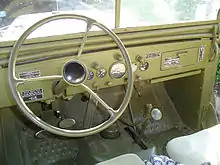
A substantial amount, and almost a quarter of all 3⁄4‑ton weapons carriers (44,229 of both WC-51 and WC-52), were provided through Lend-Lease to the Allies[76]
- 24,902 to the Soviet Union
- 10,884 to Britain
- 3,711 to China
- 3,495 to the Free French forces
- 954 to Brazil and 204 to other Latin American countries
3⁄4-ton Truck, M6 Gun Motor Carriage
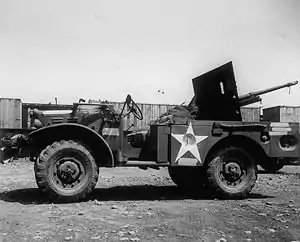
WC-55
The M6 37 mm Gun Motor Carriage, 3/4-ton, 4×4 (abbreviated as M6 GMC), or fully described "M6 Fargo Gun Motor Carriage with 37mm Anti-tank Gun," (by Dodge numbered WC-55), was a modified G-502 Dodge WC-52, designed and built to carry an M3A1 37mm anti-tank gun combined with gun shield, mounted on its cargo bed, facing rearward. The WC-55 with gun combination was designated by Standard Nomenclature List supply catalog number G-121. A total of 5,380 were built by Fargo in 1942,[84] but most were later dismantled / downgraded and returned to service as WC-52 cargo trucks.
Fielded as a stopgap design from late 1942 in North Africa, in limited use with the US Army Tank Destroyer Battalions, and in the Pacific War in 1943/1944, improvements in enemy tanks quickly rendered the 37mm gun underpowered, and better guns became available. The WC-55 was first downgraded to "limited standard" in 1943, and subsequently declared obsolete, finally by early 1945.
- Length: 14 ft 81⁄2 in (4.48 m)
- Width: 7 ft 2 in (2.18 m)
- Height: 8 ft 2 in (2.49 m) to top of gun shield
- Weight: 5,600 lb (2 540 kg)
- Storage: 80 rounds of 37mm munitions
3⁄4-ton Telephone Service
WC-59

The WC-59 Truck, Telephone Maintenance, 3/4 ton, 4×4 Dodge (G-502) was designed to install and repair telephone lines. Based on the same chassis as the WC-54 ambulances, sharing a 23 in (58 cm) longer wheelbase than the regular 3⁄4‑ton WC series. The spare wheel was carried behind the seats, and a step ladder fitted where the spare wheel normally would have been. 549 units were built. The bespoke bed made it a K-50 truck to the Signal Corps. These were initially fitted to both Dodge and Chevrolet chassis.
- Length: 16 ft 0 in (4.88 m)
- Width: 6 ft 6 in (1.98 m)
- Height: 6 ft 9 in (2.06 m)
- Weight: 5,357 lb (2,430 kg)
- Payload: 1,750 lb (800 kg)
WC-61

The WC-61 Light Maintenance Truck, 3/4 ton, 4×4 Dodge (G-502) was also designed to install and repair telephone lines. Replacement for the WC-59, the WC-61 had the step ladder mounted on the roof, the spare wheel was still fitted behind the seats, and the tool trunks were accessible from the outside. Just 58 were built. The US Signal Corps referred to these as the K-50B truck.
- Length: 15 ft 6 in (4.73 m)
- Width: 6 ft 10 in (2.08 m)
- Height (without ladder): 7 ft 5 in (2.26 m)
- Weight: 5,952 lb (2,700 kg)
- Payload: 1,750 lb (800 kg)
3⁄4-ton Truck, Emergency Repair
WC-60
_from_SNL_G-657.jpg.webp)
The WC-60 chassis, fitted with a bed similar to the WC-61 by the American Coach and Body Co. of Cleveland, Ohio, formed the M2 Emergency Repair truck, 3/4 ton, 4×4 Dodge (SNL supply code G-061), a mobile workshop designed for field maintenance. Its open-topped service-type bed featured numerous tool trunks and stowage bins, accessible from the outside. 296 units were built.
- Length: 15 ft 6 in (4.73 m)
- Width: 6 ft 10 in (2.08 m)
- Height: 7 ft 5 in (2.26 m)
- Weight: 5,952 lb (2 700 kg)
- Payload: 1,750 lb (800 kg)
One-and-a-half-ton models

.jpg.webp)
_Weapons_Carrier_pic2.JPG.webp)
WC-62
The G-507 Cargo and Personnel Carrier, 11⁄2-ton, 6x6 Truck, Dodge (WC-62 w/o Winch) was based on a lengthened WC-51 Weapons Carrier with an extra axle added. When the U.S. Army enlarged rifle squads from eight to twelve men, the 3⁄4‑ton no longer sufficed, and a 48-inch (1,200 mm) longer 6×6 variant was created that used most of the mechanical parts and some of the sheet metal of the G-502. The G-507 trucks could be driven by all six wheels (6x6) or by the four rear wheels only (6×4).[85] A number of components were strengthened in this design, and many of these changes were also incorporated in subsequent 3⁄4‑ton production. Production amounted to 43,224 units total,[5] — 23,092 WC-62 units without winch, and 20,132 WC-63 variants with winch.[73][4] One prototype was produced as an armored car.[86]
A total of 6,344 WC-62 and WC-63 cargo trucks were provided to World War II Allies — 4,074 to the Free French forces, 2,123 to British, and 137 units to Brazil.[76]
- Length: 17 ft 11 in (5.47 m)
- Width: 6 ft 11 in (2.11 m)
- Height (with canvas cover): 7 ft 3 in (2.21 m)
- Height (with top down): 5 ft 2 in (1.57 m)
- Weight: 6,925 lb (3,141 kg)
- Payload: 3,300 lb (1,500 kg)
WC-63
The WC-63 Truck, Cargo and Personnel Carrier, 11⁄2 ton, 6×6 with Winch, Dodge (G-507) Weapons Carrier was based on a lengthened WC-52 with an extra axle added. Identical to the WC-62 but fitted with a PTO-powered Braden MU2 winch, initially of 5,000 lb (2,300 kg), later 7,500 lb (3,400 kg) capacity.
- Length: 18 ft 9 in (5.72 m)
- Width: 6 ft 11 in (2.10 m)
- Height (with canvas cover): 7 ft 3 in (2.21 m)
- Height (with top down): 5 ft 2 in (1.57 m)
- Weight: 7,175 lb (3,250 kg)
- Payload: 3,300 lb (1500 kg)
Comprehensive models table
The table below lists the comprehensive set of models in the Dodge WC series family showing the different codes that were assigned together with each model's core specifications.[nb 11]
Different colors have been used to code groupings for maximum convenience, based on nominal payload rating, model family, and wheels and drive.
Lend-lease models (mainly for Russia), and Canadian-built models are presented in red, at the bottom.
| Payload rating | Dodge model | US Army SNL-nr. | Dodge T-code | Wheels & drive | U.S. Mil body code [87] | Model and body description | Winch | Years | Number built | Wheel base | Length | Width | Height | Payload |
|---|---|---|---|---|---|---|---|---|---|---|---|---|---|---|
| 1⁄2-ton | VC-1 | G-505 | T-202 | 4×4 | USM-BT-15 | Command reconnaissance | 1940 | 2,155 | 116 in (2.95 m) | 188 in (4.78 m) | 74 in (1.88 m) | 83 3⁄8 in (2.12 m) | 945 lb (429 kg) | |
| 1⁄2-ton | VC-2 | G-505 | T-202 | 4×4 | USM-BT-15 | Radio command reconnaissance | 1940 | 34 | 116 in (2.95 m) | 188 in (4.78 m) | 74 in (1.88 m) | 83 3⁄8 in (2.12 m) | ||
| 1⁄2-ton | VC-3 | G-505 | T-202 | 4×4 | USM-BT-5 | Pick-up, closed cab, with troop seats | 1940 | 816 | 116 in (2.95 m) | 188 in (4.78 m) | 74 in (1.88 m) | 88 in (2.24 m) | ||
| 1⁄2-ton | VC-4 | G-505 | T-202 | 4×4 | USM-BT-5 | Pick-up, closed cab, no bed seats | 1940 | 4 | 116 in (2.95 m) | 188 in (4.78 m) | 74 in (1.88 m) | 88 in (2.24 m) | ||
| 1⁄2-ton | VC-5 | G-505 | T-202 | 4×4 | USM-BT-9 | Pick-up, open cab / Weapon Carrier; transverse seats | 1940 | 1,607 | 116 in (2.95 m) | 188 in (4.78 m) | 74 in (1.88 m) | 88 in (2.24 m) | ||
| 1⁄2-ton | VC-6 | G-505 | T-202 | 4×4 | USM-BT-7 | Carry-all | 1940 | 24 | 116 in (2.95 m) | 74 in (1.88 m) | 84 1⁄8 in (2.14 m) | |||
| 1⁄2-ton | WC-1 | G-505 | T-207 | 4×4 | USM-BT-6 | Pick-up, closed cab; longitudinal seats | 1941 | 2,573 | 116 in (2.95 m) | 181 1⁄16 in (4.60 m) | 75 13⁄16 in (1.93 m) | 88.2 in (2.24 m) | 1000 lb / 1300 lb [nb 12] | |
| 1⁄2-ton | WC-3 | G-505 | T-207 | 4×4 | USM-BT-10 | Pick-up, open cab / Weapon Carrier; transverse seats | 1941 | 7,808 | 116 in (2.95 m) | 181 1⁄16 in (4.60 m) | 75 13⁄16 in (1.93 m) | 88 1⁄8 in (2.24 m) | 1,000 lb (450 kg) | |
| 1⁄2-ton | WC-4 | G-505 | T-207 | 4×4 | USM-BT-10 | Pick-up, open cab / Weapon Carrier; transverse seats | w / winch | 1941 | 5,570 | 116 in (2.95 m) | 191 5⁄16 in (4.86 m) | 75 13⁄16 in (1.93 m) | 88 1⁄8 in (2.24 m) | 1,000 lb (450 kg) |
| 1⁄2-ton | WC-5 | G-505 | T-207 | 4×4 | USM-BT-6 | Pick-up, closed cab; no bed seating | 1941 | 60 | 116 in (2.95 m) | 181 1⁄16 in (4.60 m) | 75 13⁄16 in (1.93 m) | 88.2 in (2.24 m) | 1000 lb / 1300 lb [nb 12] | |
| 1⁄2-ton | WC-6 | G-505 | T-207 | 4×4 | USM-BT-17 | Command reconnaissance | 1941 | 9,365 | 116 in (2.95 m) | 178 11⁄16 in (4.54 m) | 75 13⁄16 in (1.93 m) | 83 3⁄8 in (2.12 m) | 1,000 lb (450 kg) | |
| 1⁄2-ton | WC-7 | G-505 | T-207 | 4×4 | USM-BT-17 | Command reconnaissance | w / winch | 1941 | 1,438 | 116 in (2.95 m) | 189 3⁄16 in (4.81 m) | 75 13⁄16 in (1.93 m) | 83 3⁄8 in (2.12 m) | 700 lb (320 kg) |
| 1⁄2-ton | WC-8 | G-505 | T-207 | 4×4 | USM-BT-17 | Radio command reconnaissance | 1941 | 548 | 116 in (2.95 m) | 178 11⁄16 in (4.54 m) | 75 13⁄16 in (1.93 m) | 83 3⁄8 in (2.12 m) | 1,000 lb (450 kg) | |
| 1⁄2-ton | WC-9 | G-505 | T-207 | 4×4 | USM-BT-19 | Ambulance | 1941 | 2,288 | 123 in (3.12 m) | 195 in (4.95 m) | 76 in (1.93 m) | 90 in (2.29 m) | 1,000 lb (450 kg) | |
| 1⁄2-ton | WC-10 | G-505 | T-207 | 4×4 | USM-BT-7 | Carry-all | 1941 | 1,643 | 116 in (2.95 m) | 183 7⁄8 in (4.67 m) | 75 13⁄16 in (1.93 m) | 84 1⁄8 in (2.14 m) | 1,000 lb (450 kg) | |
| 1⁄2-ton | WC-11 | G-505 | T-207 | 4×4 | USM-BT-13 | Panel van | 1941 | 642 | 116 in (2.95 m) | 183 7⁄8 in (4.67 m) | 75 13⁄16 in (1.93 m) | 84 1⁄8 in (2.14 m) | 1,000 lb (450 kg) | |
| 1⁄2-ton | WC-12 | G-505 | T-211 | 4×4 | USM-BT-6 | Pick-up, closed cab | 1941 | 6,047 | 116 in (2.95 m) | 181 1⁄16 in (4.60 m) | 75 13⁄16 in (1.93 m) | 88.2 in (2.24 m) | 1000 lb / 1300 lb [nb 12] | |
| 1⁄2-ton | WC-13 | G-505 | T-211 | 4×4 | USM-BT-10 | Pick-up, open cab / Weapon Carrier | 1941 | 4,019 | 116 in (2.95 m) | 181 1⁄16 in (4.60 m) | 75 13⁄16 in (1.93 m) | 88 1⁄8 in (2.24 m) | 1000 lb / 1300 lb [nb 12] | |
| 1⁄2-ton | WC-14 | G-505 | T-211 | 4×4 | USM-BT-6 | Pick-up, closed cab / Emergency Repair [nb 13] | 1941 | 268 | 116 in (2.95 m) | 181 1⁄16 in (4.60 m) | 75 13⁄16 in (1.93 m) | 88.2 in (2.24 m) | 1000 lb / 1300 lb [nb 12] | |
| 1⁄2-ton | WC-15 | G-505 | T-211 | 4×4 | USM-BT-17 | Command reconnaissance | 1941 | 3,980 | 116 in (2.95 m) | 178 11⁄16 in (4.54 m) | 75 13⁄16 in (1.93 m) | 83 3⁄8 in (2.12 m) | 1,000 lb (450 kg) | |
| 1⁄2-ton | WC-16 | G-505 | T-211 | 4×4 | USM-BT-17 | Radio command reconnaissance | 1941 | 1,284 | 116 in (2.95 m) | 178 11⁄16 in (4.54 m) | 75 13⁄16 in (1.93 m) | 83 3⁄8 in (2.12 m) | 1,000 lb (450 kg) | |
| 1⁄2-ton | WC-17 | G-505 | T-211 | 4×4 | USM-BT-7 | Carry-all | 1941 | 274 | 116 in (2.95 m) | 183 7⁄8 in (4.67 m) | 75 13⁄16 in (1.93 m) | 84 1⁄8 in (2.14 m) | 1,000 lb (450 kg) | |
| 1⁄2-ton | WC-18 | G-505 | T-211 | 4×4 | USM-BT-19 | Ambulance | 1941 | 1,555 | 123 in (3.12 m) | 195 in (4.95 m) | 76 in (1.93 m) | 90 in (2.29 m) | 1,000 lb (450 kg) | |
| 1⁄2-ton | WC-19 | G-505 | T-211 | 4×4 | USM-BT-13 | Panel van | 1941 | 103 | 116 in (2.95 m) | 183 7⁄8 in (4.67 m) | 75 13⁄16 in (1.93 m) | 84 1⁄8 in (2.14 m) | 1,000 lb (450 kg) | |
| 1⁄2-ton | WC-20 | G-061 | T-211 | 4×4 | USM-BT-1 | Emergency repair, M1, Closed cab chassis | 1941 | 30 | 123 in (3.12 m) | 187 3⁄8 in (4.76 m) | 91 1⁄2 in (2.32 m) | 81 1⁄16 in (2.06 m) | 1420 lb / 2170 lb [nb 12] | |
| 1⁄2-ton | WC-21 | G-505 | T-215 | 4×4 | USM-BT-10 | Pick-up, open cab / Weapon Carrier; transverse seats | 1941–1942 | 14,287 | 116 in (2.95 m) | 181 1⁄16 in (4.60 m) | 75 13⁄16 in (1.93 m) | 88 1⁄8 in (2.24 m) | 1000 lb / 1300 lb [nb 12] | |
| 1⁄2-ton | WC-22 | G-505 | T-215 | 4×4 | USM-BT-10 | Pick-up, open cab / Weapon Carrier | w / winch | 1941 | 1,900 | 116 in (2.95 m) | 191 5⁄16 in (4.86 m) | 75 13⁄16 in (1.93 m) | 88 1⁄8 in (2.24 m) | 1000 lb / 1300 lb [nb 12] |
| 1⁄2-ton | WC-23 | G-505 | T-215 | 4×4 | USM-BT-17 | Command reconnaissance | 1941–1942 | 2,637 | 116 in (2.95 m) | 178 11⁄16 in (4.54 m) | 75 13⁄16 in (1.93 m) | 83 3⁄8 in (2.12 m) | 1000 lb / 1300 lb [nb 12] | |
| 1⁄2-ton | WC-24 | G-505 | T-215 | 4×4 | USM-BT-17 | Command reconnaissance | w / winch | 1941–1942 | 1,412 | 116 in (2.95 m) | 189 3⁄16 in (4.81 m) | 75 13⁄16 in (1.93 m) | 83 3⁄8 in (2.12 m) | 700 lb / 1300 lb [nb 12] |
| 1⁄2-ton | WC-25 | G-505 | T-215 | 4 x 4 | USM-BT-17 | Radio command reconnaissance | 1941–1942 | 1,630 | 116 in (2.95 m) | 178 11⁄16 in (4.54 m) | 75 13⁄16 in (1.93 m) | 83 3⁄8 in (2.12 m) | 1000 lb / 1300 lb [nb 12] | |
| 1⁄2-ton | WC-26 | G-505 | T-215 | 4 x 4 | USM-BT-7 | Carry-all | 1941–1942 | 2,900 | 116 in (2.95 m) | 183 7⁄8 in (4.67 m) | 75 13⁄16 in (1.93 m) | 84 1⁄8 in (2.14 m) | 1000 lb / 1300 lb [nb 12] | |
| 1⁄2-ton | WC-27 | G-505 | T-215 | 4×4 | USM-BT-19 | Ambulance | 1941–1942 | 2,579 | 123 in (3.12 m) | 195 in (4.95 m) | 76 in (1.93 m) | 90 in (2.29 m) | 1,300 lb (590 kg) | |
| 1⁄2-ton | WC-36 | G-613 | T-112 | 4×2 | USM-BT-7 | Carry-all | 1941 | 400 | 116 in (2.95 m) | 191 3⁄8 in (4.86 m) | 74.5[49] in (1.89 m) | 80[49] in (2.03 m) | 1,000 lb (450 kg) | |
| 1⁄2-ton | WC-37 | G-613 | T-112 | 4×2 | USM-BT-14* | Panel van — VC model civilian body | 1941 | 6 | 116 in (2.95 m) | 183 7⁄8 in (4.67 m) | 75 13⁄16 in (1.93 m) | 84 1⁄8 in (2.14 m) | 1,000 lb (450 kg) | |
| 1⁄2-ton | WC-38 | G-613 | T-112 | 4×2 | USM-BT-5* | Pick-up, closed cab – VC model civilian body | 1941 | 362 | 116 in (2.95 m) | 185 5⁄16 in (4.71 m) | 74.5 in (1.89 m) | 74 7⁄16 in (1.89 m) | 1,000 lb (450 kg) | |
| 1⁄2-ton | WC-39 | G-613 | T-112 | 4×2 | USM-BT-12 | Telephone installation, K-50 | 1941 | 1 | 116 in (2.95 m) | |||||
| 1⁄2-ton | WC-40 | G-505 | T-215 | 4×4 | USM-BT-6 | Pick-up, closed cab / Emergency Repair [nb 13] | 1941 | 275 | 116 in (2.95 m) | 181 1⁄16 in (4.60 m) | 75 13⁄16 in (1.93 m) | 88.2 in (2.24 m) | 1000 lb / 1300 lb [nb 12] | |
| 1⁄2-ton | WC-41A | G-505 | T-215 | 4×4 | USM-BT-6 | Pick-up, closed cab / Emergency Repair [nb 13] | 1941 | 39 | 116 in (2.95 m) | 181 1⁄16 in (4.60 m) | 75 13⁄16 in (1.93 m) | 88.2 in (2.24 m) | 1000 lb / 1300 lb [nb 12] | |
| 1⁄2-ton | WC-41B | G-061 | T-215 | 4×4 | USM-BT-1 | Emergency repair, M1, Closed cab chassis | 1941–1942 | 306 | 123 in (3.12 m) | 187 3⁄8 in (4.76 m) | 91 1⁄2 in (2.32 m) | 81 1⁄16 in (2.06 m) | 1420 lb / 2170 lb [nb 12] | |
| 1⁄2-ton | WC-42 | G-505 | T-215 | 4×4 | USM-BT-13 | Radio – Panel van | 1942 | 650 | 116 in (2.95 m) | 183 7⁄8 in (4.67 m) | 75 13⁄16 in (1.93 m) | 84 1⁄8 in (2.14 m) | 1000 lb / 1300 lb [nb 12] | |
| 1⁄2-ton | WC-43 | G-505 | T-215 | 4×4 | USM-BT-12 | Telephone installation, K-50 | 1942 | 370 | 116 in (2.95 m) | |||||
| 1⁄2-ton | WC-47 | G-613 | T-112 | 4×2 | USM-BT-5* | Pick-up, closed cab — VC model civilian body | 1942 | 390 | 116 in (2.95 m) | 185 5⁄16 in (4.71 m) | 74.5 in (1.89 m) | 74 7⁄16 in (1.89 m) | 1,000 lb (450 kg) | |
| 1⁄2-ton | WC-48 | G-613 | T-112 | 4×2 | USM-BT-7 | Carry-all | 1942 | 374 | 116 in (2.95 m) | 191 3⁄8 in (4.86 m) | 74.5[49] in (1.89 m) | 80[49] in (2.03 m) | 1,000 lb (450 kg) | |
| 1⁄2-ton | WC-49 | G-613 | T-112 | 4×2 | USM-BT-14* | Panel van — VC model civilian body | 1942 | 8 | 116 in (2.95 m) | 183 7⁄8 in (4.67 m) | 75 13⁄16 in (1.93 m) | 84 1⁄8 in (2.14 m) | 1,000 lb (450 kg) | |
| 1⁄2-ton | WC-50 | G-613 | T-112 | 4×2 | USM-BT-12 | Telephone installation, K-50 | 1942 | 1 | 116 in (2.95 m) | |||||
| 3⁄4-ton | WC-51 | G-502 | T-214 | 4×4 | USM-BT-11 | Pick-up, open cab / Weapon Carrier | 1942–1945 | 123,541 | 98 in (2.49 m) | 166 7⁄8 in (4.24 m) | 82 3⁄4 in (2.10 m) | 81 7⁄8 in (2.08 m) | 1,500 lb (680 kg) | |
| 3⁄4-ton | WC-52 | G-502 | T-214 | 4×4 | USM-BT-11 | Pick-up, open cab / Weapon Carrier | w / winch | 1942–1945 | 59,114 | 98 in (2.49 m) | 176.5 in (4.48 m) | 82 3⁄4 in (2.10 m) | 81 7⁄8 in (2.08 m) | 1,500 lb (680 kg) |
| 3⁄4-ton | WC-53 | G-502 | T-214 | 4×4 | USM-BT-8 | Carry-all | 1942–1943 | 8,400 | 114 in (2.90 m) | 185 5⁄8 in (4.71 m) | 78 5⁄8 in (2.00 m) | 80 1⁄4 in (2.04 m) | 1,800 lb (820 kg) | |
| 3⁄4-ton | WC-54 | G-502 | T-214 | 4×4 | USM-BT-20 | Ambulance | 1942–1944 | 26,002 | 121 in (3.07 m) | 194.5 in (4.94 m) | 77 3⁄4 in (1.97 m) | 90 3⁄8 in (2.30 m) | 1,800 lb (820 kg) | |
| 3⁄4-ton | WC-55 | G-121 | T-214 | 4×4 | USM-BT-11 | Pick-up, open cab "M6 Gun Motor Carriage" | w / winch | 1942 | 5,380 | 98 in (2.49 m) | 178 in (4.52 m) | 88 in (2.24 m) | 82 in (2.08 m) | 1,200 lb (540 kg) |
| 3⁄4-ton | WC-56 | G-502 | T-214 | 4×4 | USM-BT-16 | Command reconnaissance | 1942–1944 | 21,156 | 98 in (2.49 m) | 165 3⁄4 in (4.21 m) | 78 5⁄8 in (2.00 m) | 81.5 in (2.07 m) | 1500 lb / 1800 lb [nb 12] | |
| 3⁄4-ton | WC-57 | G-502 | T-214 | 4×4 | USM-BT-16 | Command reconnaissance | w / winch | 1942–1944 | 6,010 | 98 in (2.49 m) | 175 5⁄8 in (4.46 m) | 78 5⁄8 in (2.00 m) | 81.5 in (2.07 m) | 1500 lb / 1800 lb [nb 12] |
| 3⁄4-ton | WC-58 | G-502 | T-214 | 4 x 4 | USM-BT-16 | Radio command reconnaissance | unclear | 1942 | 2,344 [nb 14] | 98 in (2.49 m) | 165 3⁄4 in (4.21 m) | 78 5⁄8 in (2.00 m) | 81.5 in (2.07 m) | 1500 lb / 1800 lb [nb 12] |
| 3⁄4-ton | WC-59 | G-502 | T-214 | 4 x 4 | USM-BT-21 | Telephone installation, K-50 | 1942–1943 | 549 | 121 in (3.07 m) | 191.5 in (4.86 m) | 77.5 in (1.97 m) | 80 5⁄8 in (2.05 m) | 500 lb / 1210 lb [nb 12] | |
| 3⁄4-ton | WC-60 | G-061 | T-214 | 4×4 | USM-BT-22 | Emergency repair, M2, Closed cab chassis | 1943 | 300 | 121 in (3.07 m) | 186 in (4.72 m) | 81.5 in (2.07 m) | 88.5 in (2.25 m) | 2,170 lb (980 kg) | |
| 3⁄4-ton | WC-61 | G-502 | T-214 | 4×4 | Phone / Maintenance, K-50B | 1943 | 58 | 121 in (3.07 m) | 191 13⁄32 in (4.86 m) | 77 3⁄4 in (1.97 m) | 80 11⁄16 in (2.05 m) | 1,300 lb (590 kg) | ||
| 3⁄4-ton | WC-64 | G-502 | T-214 | 4×4 | Ambulance, Knock-down | 1945 | 3,500 | 121 in (3.07 m) | 191.5 in (4.86 m) | 82 3⁄4 in (2.10 m) | 90 3⁄4 in (2.31 m) | 1,500 lb (680 kg) | ||
| 11⁄2-ton | VF-401 | G-621 | T-203 | 4×4 | USM-BT-3 | Pick-up / cargo, closed cab | 1940 | 3,122 | 143 in (3.63 m) | 223 3⁄8 in (5.67 m) | 86 in (2.18 m) | 111 7⁄8 in (2.84 m) | 3,000 lb (1,400 kg) | |
| 11⁄2-ton | VF-402 | G-621 | T-203 | 4×4 | USM-BT-3 | Pick-up / cargo, closed cab | w / winch | 1940 | 491 | 143 in (3.63 m) | 233 1⁄12 in (5.92 m) | 86 in (2.18 m) | 111 7⁄8 in (2.84 m) | 2,400 lb (1,100 kg) |
| 11⁄2-ton | VF-403 | G-621 | T-203 | 4×4 | USM-BT-4 | Dump truck, closed cab | 1940 | 323 | 143 in (3.63 m) | 225 3⁄32 in (5.72 m) | 85 in (2.16 m) | 113.5 in (2.88 m) | 3,000 lb (1,400 kg) | |
| 11⁄2-ton | VF-404 | G-621 | T-203 | 4×4 | USM-BT-3 | Pick-up / cargo, closed cab | 1940 | 1,956 | 143 in (3.63 m) | 223 3⁄8 in (5.67 m) | 86 in (2.18 m) | 111 7⁄8 in (2.84 m) | 3,000 lb (1,400 kg) | |
| 11⁄2-ton | VF-405 | G-621 | T-203 | 4×4 | USM-BT-3 | Pick-up / cargo, closed cab | w / winch | 1940 | 509 | 143 in (3.63 m) | 233 1⁄12 in (5.92 m) | 86 in (2.18 m) | 111 7⁄8 in (2.84 m) | 2,400 lb (1,100 kg) |
| 11⁄2-ton | VF-406 | G-621 | T-203 | 4×4 | USM-BT-4 | Dump truck, closed cab | 1940 | 67 | 143 in (3.63 m) | 225 3⁄32 in (5.72 m) | 85 in (2.16 m) | 113.5 in (2.88 m) | 3,000 lb (1,400 kg) | |
| 11⁄2-ton | VF-407 | G-621 | T-203 | 4×4 | USM-BT-18 | Ambulance | 1940 | 3 | 143 in (3.63 m) | |||||
| 11⁄2-ton | WC-62 | G-507 | T-223 | 6×6 | USM-BT-25/26 | (Personnel and) Cargo Carrier | 1943 | 23,092 | 125 in (3.18 m) [nb 15] | 214 7⁄8 in (5.46 m) | 82 3⁄4 in (2.10 m) | 893⁄4 in / 843⁄4 in [nb 16] | 3,300 lb (1,500 kg) | |
| 11⁄2-ton | WC-63 | G-507 | T-223 | 6×6 | USM-BT-23/24 | (Personnel and) Cargo Carrier | w / winch | 1943 | 20,132 | 125 in (3.18 m) [nb 15] | 224 3⁄4 in (5.71 m) | 82 3⁄4 in (2.10 m) | 893⁄4 in / 843⁄4 in [nb 16] | 3,300 lb (1,500 kg) |
| 11⁄2-ton | T-203B | T-203-B | 4×4 | Lend-lease | Cargo truck / Lend-Lease to Russia | 1940 | 1,500 [90] | 160 in (4.06 m) | ||||||
| 11⁄2-ton | WF-32 | G-618 | T-118 | 4×2 | Lend-lease; made in Iran | Closed cab, stake and platform | 1942–1944 | 9,600 [34] | 160 in (4.06 m) | 253.5 in (6.44 m) | 88 in (2.24 m) | 82 11⁄16 in (2.10 m) | 3,170 lb (1,440 kg) | |
| 1⁄2-ton | D8A | — | T-212 | 4×4 | Canadian production | Pick-up, open cab / Weapon Carrier | 3,001 [6] | 116 in (2.95 m) | ||||||
| 3⁄4-ton | D3/4 APT | — | T-236 | 4×4 | Canadian production | Pick-up, open cab / Weapon Carrier; Air-Portable | 1945 | 11,750 [6] | 98 in (2.49 m) | 182 in (4.62 m) | 77 1⁄8 in (1.96 m) | 62 in (1.57 m) | 1,750 lb (790 kg) |
Service history
Former operators
At least two survived in running condition in Russian museums:
|
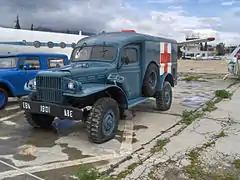 WC-54 ambulance in period Greek Airforce colors 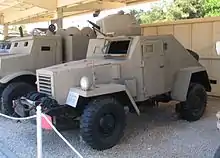 Israel built ad-hoc reconnaissance-assault car with 'sandwich' armor and turret, on the Dodge WC-52 chassis, for the 1948 independence war.[94]
|
Gallery
.jpg.webp) Generals George Patton and Auguste Nogues (Commander-in-Chief in French North Africa) in a WC-56 reviewing troops Dec. 1942
Generals George Patton and Auguste Nogues (Commander-in-Chief in French North Africa) in a WC-56 reviewing troops Dec. 1942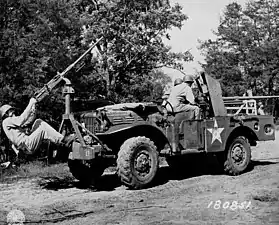 WC-55 in a posed picture showing the M2 heavy machine gun for anti-aircraft use
WC-55 in a posed picture showing the M2 heavy machine gun for anti-aircraft use French Army draisine, converted WC-51
French Army draisine, converted WC-51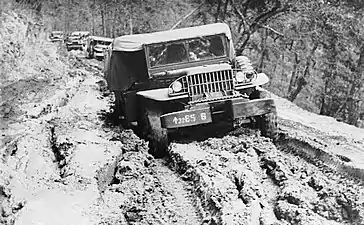 A Dodge of the 5th Indian Division struggling through mud on the Tiddim Front during the Burma campaign, 1941–1945
A Dodge of the 5th Indian Division struggling through mud on the Tiddim Front during the Burma campaign, 1941–1945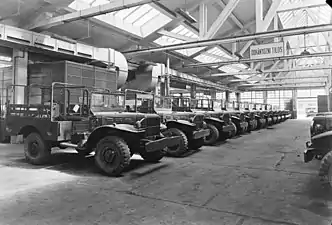 WC-51 'Beeps' served in the Polish and Hungarian armies in the '40s and '50s.[95]
WC-51 'Beeps' served in the Polish and Hungarian armies in the '40s and '50s.[95].jpg.webp) General George C. Marshall in Dodge Command Car, 1944
General George C. Marshall in Dodge Command Car, 1944 Five Royal Dutch Marechaussee riding in a WC-56/-57 Command Car – 1946, Bogor, West Java, during the Indonesian war of independence.
Five Royal Dutch Marechaussee riding in a WC-56/-57 Command Car – 1946, Bogor, West Java, during the Indonesian war of independence.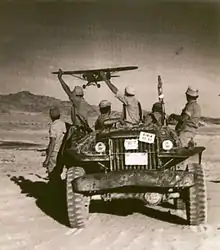 Israeli Defense Forces (IDF) Dodge jeep in the taking of the Sinai peninsula (1956)
Israeli Defense Forces (IDF) Dodge jeep in the taking of the Sinai peninsula (1956)
In popular culture
Dodge WC series vehicles are visible in many World War II movies, and American TV series. One of the most conspicuous examples is the frequent use of the WC-54 ambulances in the acclaimed M*A*S*H TV series, situated in the Korean War.
In many WW II films, directors would place high-ranking allied officers in Dodge Command Cars, although in reality, the German military quickly realized that personnel riding in the Command Cars were typically prime targets, and Allied generals and dignitaries would in reality prefer to ride in regular jeeps, to prevent advertising themselves as high-profile targets.
See also
- Canadian Military Pattern truck
- Dodge 3-ton 'Burma' truck
- List of Dodge automobiles
- Standard nomenclature vehicle G-numbers – G-061, G-121, G-502, G-505, G-507, G-613, G-618, G-621
- Humvee – another U.S. light military wheeled vehicle platform, with many variants built using the same mechanicals
- World War II jeep – the other of the two American light wheeled vehicles, mass-produced for World War II
Notes
- Chrysler Corporation Mopar's 1946 annual model chart and serial number guide indicates 4,640 1⁄2‑ton VC units, and a maximum of 77,765 1⁄2‑ton WC serial numbers: [3]
– 31,935 units of the WC-1 through WC-11,
– 17,293 units of the WC-12 through WC-20, and
– 28,537 units of the WC-21 through WC-27 and WC-40 through WC-43 - The Summary Report – Tank-Automotive Materiel lists a total of 82,454 1⁄2‑ton 4×4 trucks (page 58), including 65 Marmon-Herrington Fords (p. 57) and 12 'Amphibian Car Corp.' units (p. 55), and a matching number of 4640 VC-series units (1940), leaving 82,377 half-ton G-505‑series 4×4 units
- Shortened from "Big jeep"
- Although within the Chrysler Corporation, the Fargo Division handled government contracts,[10] the trucks were all built at Dodge’s Mound Road, Warren truck plant near Detroit, Michigan.[5][11]
- Including the 4,640 G-505 VC trucks of 1940
- The U.S. Army at that time grouped motor transport vehicles into four weight classes — 3⁄4‑ton or one-ton and under were "light", 11⁄2‑tons were "medium", and above that were two groups of "heavies".[5][12]
- Chrysler Corp. Mopar's 1946 annual model chart and serial number guide indicates 6,472 serial numbers across the VF-400 models,[7] exactly matching Dodge's contract W-398-QM-7471 for 3,936 units, and Fargo's contract W-398-QM-7813 for 2,534 units, plus one pilot truck each.[8] The 1946 Summary Report of Acceptances – Tank-Automotive Materiel lists another 292 cargo trucks in addition to these same numbers, but under earlier contracts, matching the 292 TF-40(-X) / T-201 pre-standard units from 1939.[30]
- truck with bed-mounted gun, typically unarmored, except for possibly a gun shield
- Recommended fuel octane was just 60–65.[54]
- U.S. government contracts explicitly referred to these units as T-211 models with a T-215 engine.[63]
- Based on Dodge's SNL G-657 Master Parts List (1943), U.S. Army technical model manuals, such as the TM9-2800 (1943 and 1947 editions) and others, and the U.S. Summary Report of Tank Automotive Acceptances (1945/1946).
- Ratings given in Technical Manual TM9-2800 editions of 1943 and 1947, respectively.[88] [89]
- According to both contract and acceptance count in Summary Report
- Unclear whether 2344 were built in addition to the WC-56/57 units, or whether this number of these were equipped as radio units !
- 104 in (2.64 m) + 42 in (1.07 m)
- TM9-810: max. height: tarpaulin up, with / without ringmount; Lowest operable reducible to 62 in (1.57 m)
References
- SNL G-657 Master Parts List (1943), p. XX–XXII.
- Summary Report – Tank-Automotive Materiel (1945), pp. 55–58.
- Serial Number Guide – Dodge Trucks Built for the U.S. Government (1946), Page 24 & 25.
- Summary Report – Tank-Automotive Materiel (1945), p. 66.
- Hyde, Charles K. (2013). Arsenal of Democracy: The American Automobile Industry in World War II. Wayne State University Press. pp. 152–153. ISBN 9780814339527.
- Dodge / Fargo start and end serials for T-212, T-236 and other types
- "Serial Number Guide – Dodge Trucks Built for the U.S. Government". T137.com. Archived from the original on 18 July 2016. Retrieved 15 February 2018.
scanned images of parts books pages showing serial numbers, engine numbers, and other information from factory MoPar parts books covering Dodge and Fargo trucks manufactured from 1939–1977
- Doyle, David (2019). Chevrolet G-506 – 11⁄2-ton 4x4 Development, Production and Variants in WW2. Branchville, NJ: Portrayal Press. p. 8. ISBN 9780938242062. Archived from the original on 8 April 2019.
- "TM 9 808 Dodge 3⁄4 ton 4x4". US Dept. of the Army. 31 January 1944. Retrieved 30 August 2015.
- Summary Report – Tank-Automotive Materiel (1945), pp. 19, 58, 64.
- Doyle, David (28 February 2011). Doyle, 2011: Standard Catalog of U.S. Military Vehicles – 2nd Edition, pg. 100. ISBN 9781440227998. Archived from the original on 20 June 2018. Retrieved 26 April 2018.
- Thomson, Harry C.; Mayo, Lida (2003). The Ordnance Department: procurement and supply. Washington, D.C.: Center of Military History, U.S. Army (Originally published: 1960, Washington, D.C., Office of the Chief of Military History, Dept. of the Army). p. 269/270.
- "Truck, 1/2 ton, 4x4, Dodge WC (G505)". Olive-drab.com. Retrieved 13 February 2018.
- Kochnev, Evgeny (13 October 2019). "Lend-lizovskiye «tri chetverti»_ o takikh mashinakh v Krasnoy armii i ne mechtali" Ленд-лизовские «три четверти»_ о таких машинах в Красной армии и не мечтали ["Three Quarters" from the USA: Lend-Lease Dodge WC in the Red Army]. KOLESA.ru. Automotive magazine (in Russian). Retrieved 4 February 2021.
- Allen, Jim (7 December 2016). "1943 Dodge WC-51 Weapons Carrier, Power & Glory: Backward Glances". FourWheeler.com. Extreme Ventures, LLC. Retrieved 24 February 2018.
- Jowett, Philip; de Quesada, Alejandro (28 February 2006). The Mexican Revolution 1910–20. Osprey. p. 25. ISBN 978-1-84176-989-9.
- DeLorenzo, Matt (15 February 2014). Dodge 100 Years. MotorBooks International. p. 55. ISBN 9781627880848.
- Allen, Jim (2009). Four-Wheeler's Bible. MotorBooks International. p. 21. ISBN 9781616730888.
- 1946-1948 Dodge Power Wagon – HowStuffWorks
- Bunn, Don (26 September 2012). "1940–1980: Power Wagon Pickups". One Classics. Retrieved 22 May 2018.
- "History of the Dodge Pickup Trucks, 1921–1953". Allpar. Retrieved 15 February 2018.
- Hyde (2013), page 147–148.
- Thomson & Mayo (2003), page 271.
- Will The Real Jeep Please Stand Up – Offroaders.com
- Thomson & Mayo (2003), page 274.
- "Pages of Interest to 4x4ers: 4x4 History – Where It All Began". Dog-walker.us. Archived from the original on 11 February 2014. Retrieved 6 June 2013.
- Zaloga, Steven J. (2011). Jeeps 1941–45. Bloomsbury Publishing. ISBN 9781780961477. Retrieved 27 January 2018.
- Morr, Tom; Brubaker, Ken (2007). Jeep Off-Road. MotorBooks International. p. 11. ISBN 9781610590563. Retrieved 27 January 2018.
- Truck, 1/2 ton, 4x4, Dodge VC (G505) – Olive Drab
- Summary Report – Tank-Automotive Materiel (1945), pp. 66–69.
- 1940 Dodge VF-401 Cargo Trucks (archived)
- Dodge Trucks – US auto industry in WW II
- Ordnance Publications For Supply Index (OPSI). Washington: War Department, Ordnance Office. 1 July 1943. pp. 104–108, 123–125.
- Dodge WF32 – Lend-Lease Legends (in Russian)
- Lend Lease trucks in Russia (archived)
- Dodge WF-32 – Engines of the Red Army in WW2
- David D. Jackson (2010). Chrysler's contribution to the war effort during WWII (Museum wall plaque). Auburn Hills, Michigan: Walter P. Chrysler Museum. Retrieved 16 May 2018.
- Serial Number Guide – Dodge Trucks Built for the U.S. Government (1946), Page 25.
- "Dodge Military Trucks". Olive-drab.com. Retrieved 6 June 2013.
- T. Richards and R.M. Clarke, op. cit. pg 24–26
- SNL G-657 Master Parts List (1943), p. 296.
- Doyle, 2011: Standard Catalog of U.S. Military Vehicles – 2nd Edition, pg. 56
- Article page on the 11⁄2-ton 4x4 VF400 series
- David Doyle: Standard Catalog of U.S. Military Vehicles – 2nd Edition, pg. 44
- TM 9-808 – 3⁄4-Ton 4x4 Truck (Dodge), Technical Manual (1944), p. 12.
- SNL G-657 Master Parts List, Dodge Trucks, US Army, 1944, Front cover (archived)
- T Flathead Six Engines – T137.com
- TM 9-2800 'Standard Military Motor Vehicles' (1943).
- TM 9-2800-1/TO 19-75A-89 – Military Vehicles (PDF). Technical Manual. Washington: Departments of the Army and the Air Force. 13 February 1953. p. 157.
- TM9-2800 manual (1947), p. 224, 231.
- TM9-2800 manual (1947), p. 243.
- 1940 Dodge VC-3 Express poster and specs – Gary Grant Robertson (archived)
- TM9-2800 manual (1947), page 248, 254.
- Dodge WC-6 (T-207) dashboard data plate (archived)
- TM9-2800 manual (1947), p. 230, 232.
- TM9-2800 manual (1947), p. 234–239.
- TM9-808 3⁄4-ton 4x4 Dodge Truck Manual, 1944, page 13
- TM9-2800 manual (1947), p. 227, 228, 229.
- TM9-2800 manual (1947), p. 261.
- 1939 Dodge Half Three Quarter One Ton Trucks TC & TD Series Specs Sale Brochure (archived 7 April 2019)
- Autopaper 1939 Dodge Trucks brochure specifications archived 7 April 2019)
- Ordnance Department Administrative and Tactical Vehicles per QMC Contract.nr, 1940 through 1 January 1944 (Dodge T-207) (archived 6 March 2006)
- Ordnance Department Administrative and Tactical Vehicles per QMC Contract.nr, 1940 through 1 January 1944 (Dodge T-211) (archived 29 April 2015)
- "Dodge WWII WC 1/2 Ton 4x4 Information & Parts". Vintage Power Wagons.
- "Dodge WC9 WC18 WC27 Truck, 1/2 ton Ambulance". Olive-drab.com. Retrieved 6 June 2013.
- TM9-2800 manual (1943), page 155.
- Summary Report – Tank-Automotive Materiel (1945), p. 57.
- Ordnance Department Administrative and Tactical Vehicles per QMC Contract.nr, 1940 through 1 January 1944 (Dodge T-215) (archived)
- SNL G-657 Master Parts List (1943), pp. VI; XX–XXII.
- Summary Report – Tank-Automotive Materiel (1945), p. 56.
- Dodge Weapons Carrier depiction
- Summary Report – Tank-Automotive Materiel (1945), p. 62.
- Benedict, Chris (July 1979). "Dodge 3/4 Ton 4X4 And 1½ Ton 6X6 Production, 1942–1945". Army Motors magazine.
- Dodge WC-64 KD Ambulance – Technical
- "Dodge WC64KD Ambulance History". Guido Wilmes. Archived from the original on 9 December 2013. Retrieved 6 June 2013.
- U.S. Ordnance Corps (31 December 1946). "III-B "Ordnance - Motor Transport Vehicles", Part I". Quantities of Lend-Lease Shipments (PDF) (Report). U.S. War Department. p. 1. Archived (PDF) from the original on 31 December 2018. Retrieved 17 June 2019.
- 1942 Dodge Power Wagon WC-53 Carryall Bring a Trailer, 2010
- SNL G-657 Master Parts List (1943), page 381.
- Dodge: Cinq generations de tous terrains – Boniface and Jeudy (in French)
- Summary Report – Tank-Automotive Materiel (1945), p. 63.
- SNL G-657 Master Parts List (1943), p. XIII; 296.
- David Doyle : Standard Catalog of U.S. Military Vehicles – 2nd Edition, pg. 60
- Dodge WC-58 Truck, Radio, 3/4 ton, 4x4 with winch (G-502), Olive-Drab
- Summary Report – Tank-Automotive Materiel (1945), p. 19.
- U.S. Army Technical Manual TM9-1808B, 1943, page 4
- "T230 "Fargo" 6x6 Armored Car". Warwheels.net. Retrieved 6 June 2013.
- SNL G-657 Master Parts List (1943).
- TM9-2800 manual (1943).
- TM9-2800 manual (1947).
- Dodge T-203B – Engines of the Red Army in WW2
- JWH1975 (14 June 2015). "Rearming Austria: WWII weapons". wwiiafterwwii.
- Kochnev, Evgenii (2010). Военные автомобили Союзников [Military cars of the Allies] (in Russian). Moscow: Yauza. Eksmo. p. 512. ISBN 978-5-699-41199-3.
- "Swissmotor / Dodge". Swissmotor.com. Retrieved 6 June 2013.
- Yuri Pasholok, 27 August 2017 "Israeli Sandwiches" Tank Archives
- Rossagraph Dodge WC-51 monograph Review, Armorama]
General references
- Chief of Ordnance Office; Military Vehicle Preservation Association, eds. (2010). Summary Report of Acceptances, Tank-Automotive Materiel, 1940–1945 (Revision). Detroit: U.S. Army Service Forces, Office: Chief of Ordnance-Detroit, Production Division, Requirements and Progress Branch (published December 1945).
- Crismon, Fred W. (2001). US Military Wheeled Vehicles (3 ed.). Victory WWII Pub. pp. 96, 98, 240–241. ISBN 0-970056-71-0.
- Doyle, David (2003). Standard catalog of U.S. Military Vehicles. Iola, Wisconsin: Krause Publications. pp. 45–49, 55–62, 100–101. ISBN 0-87349-508-X.
- Doyle, David (2011). Standard Catalog of U.S. Military Vehicles - 2nd Edition. Iola, Wisconsin: Krause Publications. ISBN 9781440225727.
- Richards, T. and Clarke, R.M. Dodge WW2 military portfolio 1940-45. Brookland Books LTD (Surrey, UK) ISBN 1-85520-533-5
- Ware, Pat (2010). The World Encyclopedia of Military Vehicles. Lorenz Books. pp. 232–233. ISBN 978-0-7548-2052-9.
- SNL G-657 – Master Parts List, Dodge Trucks. Standard Nomenclature Supply Catalog. Ordnance Department, United States Army Service Forces. 1 December 1943. Ten page sample here (pdf)
- TM 9-808 – 3⁄4‑Ton 4x4 Truck (Dodge), Technical Manual (PDF). Technical Manual. U.S. War Department. 31 January 1944.
- TM 9-810 – 11⁄2-Ton 6x6 Truck (Dodge T-223, models WC-62 and WC-63) (PDF). Technical Manual. U.S. War Department. 28 February 1945.
- TM 9-2800 – Standard Military Motor Vehicles. Technical Manual. Washington: U.S. War Department. 1 September 1943.
- TM 9-2800 – MILITARY VEHICLES (PDF). Technical Manual. Washington: Department of the Army. 27 October 1947.
- TM 10-1443 – 1⁄2 Ton 4 x 4 Dodge Trucks for U.S. Army (PDF). Maintenance Manual. Washington: U.S. War Department. 20 February 1942.
External links
| Wikimedia Commons has media related to Dodge WC series. |
- Dodge WC, Primal4x4 Dodge WWII 4x4 – includes the retired "WW2 Dodge Motor Pool" site
- Gordon's WW2 Army Trucks
- A WC-52 Restoration Project
- command-car.com – dedicated to Dodge Command Car of WW2
- WW II 3/4 Ton, 4x4 Dodge WC Information Page – on Vintage Power Wagons
- "The Jeep Gets a Big Brother", November 1942, Popular Science – early article introducing the American war public to the redesigned 3⁄4‑ton WC‑series
